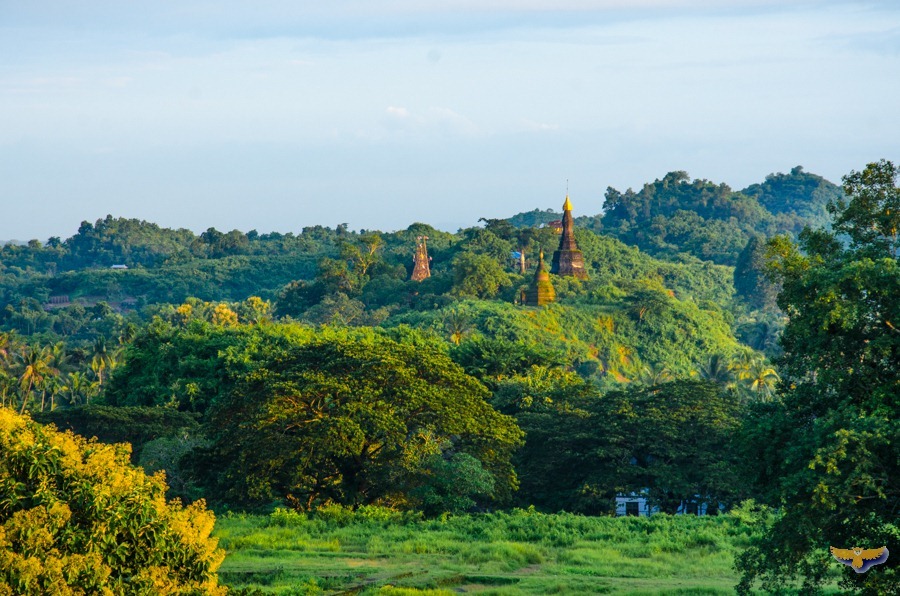The Mrauk U Kingdom was founded in 1430 by King Min Saw Mon, and
Mrauk U remained the capital for more than three hundred and fifty
years, until 1785. At its peak, Mrauk U controlled half of Bangladesh
and the western part of Lower Burma. Its fame spread to far Europe where
it became known as a city of oriental splendor after the Portuguese
missionary and traveler, Fray Sebastien Manrique, published a vivid
account of the coronation of King Thiri Thudhamma in 1635 and about the
Rakhine Court.
As the city grew, the King and the rich inhabitants built many Buddhist pagodas and temples. Some are still being used as places of worship, and these are the main attraction of Mrauk-U. In fact, Mrauk U’s rich collection of temples and pagodas is second only to Bagan, but unlike Bagan, Mrauk U isn’t swarmed with tourists. This is because the place is not easy to reach. There’s no airport, and the only way to get there is by a boat, which takes about 7 to 8 hours.
One thing that sets Mrauk U apart from other popular archeological sites is the local life here that runs right in the heart of this historical site.
Travel writer Robert Reid describes his visit to Mrauk U in a BBC article:
Being the former capital of the Arakan empire, Mrauk U was surrounded by long defensive walls and moats, at the center of which stood the Royal Palace. Very little of the palace remains today.

Photo credit: Jean-Marie Hullot/Flickr

Photo credit: Stefan Munder/Flickr

Photo credit: Stefan Munder/Flickr

Photo credit: Arian Zwegers/Flickr

Photo credit: dany13/Flickr

Photo credit: Anne Dirkse/Flickr

Photo credit: Bernhard Huber/Flickr

Photo credit: François Bianco/Flickr

Photo credit: dany13/Flickr

Photo credit: Steffen Korn/Flickr

Photo credit: Bernhard Huber/Flickr
Sources: Renown Travel / Wiki Travel / Wikipedia / www.backpekka.com
http://www.amusingplanet.com/2017/04/the-forgotten-ruins-of-mrauk-u.html
As the city grew, the King and the rich inhabitants built many Buddhist pagodas and temples. Some are still being used as places of worship, and these are the main attraction of Mrauk-U. In fact, Mrauk U’s rich collection of temples and pagodas is second only to Bagan, but unlike Bagan, Mrauk U isn’t swarmed with tourists. This is because the place is not easy to reach. There’s no airport, and the only way to get there is by a boat, which takes about 7 to 8 hours.
One thing that sets Mrauk U apart from other popular archeological sites is the local life here that runs right in the heart of this historical site.
Travel writer Robert Reid describes his visit to Mrauk U in a BBC article:
Here, the ruins are merely a backdrop to everyday life. Streams of young women fill tin pots at temple-side wells and take short cuts over cracked pagoda steps to farms sandwiched between 500-year-old stupas. Elders crouch below trees, amid smoking refuse piles and goat herds.Another difference between Bagan and Mrauk U is that unlike in Bagan, none of the temples in Mrauk U are closed, and can be explored inside out. Although there are far more temples in Bagan than in Mrauk U, the views from the surrounding hills are no less breathtaking. The temples are also different to those in Bagan, made of hewn stone bricks rather than mud and brick. Some of the temples were built like bunkers with thick solid walls, and were probably used as places of refuge during times of war.
Being the former capital of the Arakan empire, Mrauk U was surrounded by long defensive walls and moats, at the center of which stood the Royal Palace. Very little of the palace remains today.

Photo credit: Jean-Marie Hullot/Flickr

Photo credit: Stefan Munder/Flickr

Photo credit: Stefan Munder/Flickr

Photo credit: Arian Zwegers/Flickr

Photo credit: dany13/Flickr

Photo credit: Anne Dirkse/Flickr

Photo credit: Bernhard Huber/Flickr

Photo credit: François Bianco/Flickr

Photo credit: dany13/Flickr

Photo credit: Steffen Korn/Flickr

Photo credit: Bernhard Huber/Flickr
Sources: Renown Travel / Wiki Travel / Wikipedia / www.backpekka.com
http://www.amusingplanet.com/2017/04/the-forgotten-ruins-of-mrauk-u.html


.jpg)






